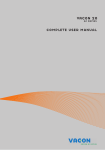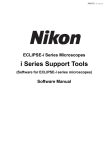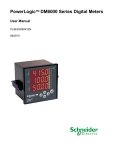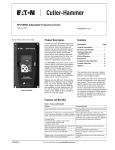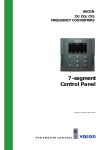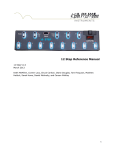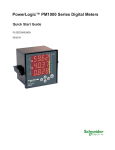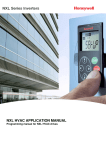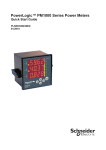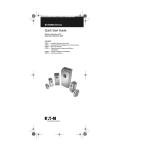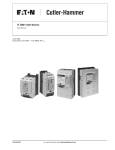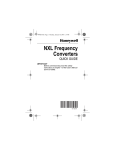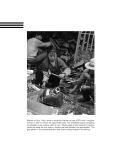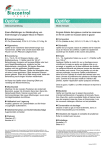Download SV9000 AF Drives — Motor Pump Enhanced Protection Application
Transcript
SV9000 AF Drives — Motor Pump Enhanced Protection Application Application Manual June 2004 Supersedes February 2001 MN04001002E For more information visit: www.eatonelectrical.com Page ii (60) Motor Pump Enhanced Protection Application Updates Update Note: 1 Page 2 — Figure 3-1 — DIA3 (par. 2.2 = 10) becomes DIA2 (par. 11.1 = 10) Update Note: 2 Page 17— Addition to Code 12.1 Description — 23 = Hot Motor Winding Detection 24 = Hot Motor Bearing Detection 25 = Seal Leak Detection 26 = High Vibration Detection 27 = Warn Flash Update Note: 3 Page 17 — Addition to Code 12.3 Description — 27 = Warn Flash SV9000 Page iii Manual Title SV9000 Motor Pump Enhanced Protection Application Contents 1 2 3 4 5 6 7 8 9 General........................................................ 2 Control I/O ................................................... 2 Control Signal Logic .................................... 2 Parameter Group 0...................................... 3 4.1 Application Selection ............................ 3 4.2 Parameter Loading ............................... 3 4.3 Language .............................................. 3 Basic Parameters, Group 1 ......................... 4 5.1 Parameter Table ................................... 4 5.2 Description of Group 1 Parameters ...... 5 Special parameters, Groups 2—10............. 9 6.1 Parameter tables................................... 9 6.2 Description of Groups 2-10 Parameters ............................................................ 19 Fault Code ................................................. 52 Monitoring Data ......................................... 52 SV9IOC103 Control Connections ............. 53 Page iv (60) Motor Pump Enhanced Protection Application SV9000 Page 1 (60) Motor Pump Enhanced Protection Application SV9000 1 General The Motor Pump Enhanced Protection application is a modified version of the normal Multi-Purpose application. It has parameters for torque control and for Fieldbus communication. The following fieldbuses are supported: Interbus, Modbus, LonWorks, CAN-bus (SDS, DeviceNet). The frequency reference, the analog and digital outputs have extra alternatives in their control parameters, however, the source of the free analog input can not be selected from the I/O Expander as in the Multi-Purpose II application. Lastly, this application allows for up to four (4) additional custom inputs, faults, and fault indicators (when an additional I/O board is installed). 2 Control I/O Terminal 1 +10Vref 2 V in+ READY RUN 220 VAC Signal Reference output Analog input, voltage (programmable) I/O Ground Analog input, current (programmable) Control voltage output I/O ground Start forward Programmable Input Fault reset 3 4 5 6 7 8 9 10 GND Iin+ Iin+24V GND DIA 1 DIA 2 DIA 3 11 12 13 14 CMA +24V GND DIB4 Common for DIA 1—DIA 3 Control voltage output I/O ground Jog speed select (programmable) 15 16 DIB5 DIB6 Programmable Input Acceleration/deceleration time select (programmable) 17 18 19 20 CMB Iout+ IoutDO1 21 22 23 24 25 26 RO1 RO1 RO1 RO2 RO2 RO2 Common for DIB4—DIB6 Output frequency Analog output Digital output READY Relay output 1 RUN Relay output 2 Description Voltage for potentiometer, etc. Frequency reference range 0—10 V DC Ground for reference and controls Default setting: not used, range 0—20 mA Voltage for switches, etc. max 0.1 A Ground for reference and controls Contact closed = start forward Contact closed = Enable 11.1.3 Contact open = no action Contact closed = fault reset Connect to GND or +24V Voltage for switches (see #6) Ground for reference and controls Contact open = no action Contact closed = jogging speed Default = Not Used Contact open = par. 1.3, 1.4 in use Contact closed = par. 4.3, 4.4 in use Connect to GND or +24V Programmable, (par. 3.1) Range 0—20 mA/RL, max. 500Ω Programmable, (par. 12.1) Open collector, I≤50mA, U≤48 VDC Programmable, (par. 12.2) Programmable, (par. 12.3) Default = Not used Figure 2-1 Default I/O configuration and connection example of the Motor Pump Enhanced Protection Application Page 2 (60) Motor Pump Enhanced Protection Application SV9000 3 Control Signal Logic PARAMETERS 1. 5 Reference selection 1. 6 Jog speed ref. 10.1 Fieldbus control . U in + Iin ± Joystick control Joystick control Vin + I in Vin I in Vin I in V in x I in min(Vin,Iin) max(Vin,Iin) Multi step speeds (If any of DI_ inputs are pro grammed for this function) Internal frequency reference P Fieldbus U in + PROGRAMMABLE PUSH BUTTON 2 Par . 6.1 Motor control mode Motor control mode Torque control DIA3 (par. 2.2=10) Torque reference scaling speed DIB4 Jogging selection (programmable) DIA1 Start FWD Programm. DIA2 Start/Stop Logic DIA3 Fault reset Update Note: 1 Torque reference Par . 9.1 Torque reference selection Fieldbus P Internal Start/Stop P Internal reverse Fieldbus >1 Internal fault reset DIB5 Programmable Input DIB6 Accel./deceler. time select (programmable) = controlline = signalline MP2BLOCK Figure 3-1: Control Signal Logic of the Motor Pump Enhanced Protection Application Switch positions correspond to factory settings. SV9000 Motor Pump Enhanced Protection Application Page 3 (60) 4 Parameter Group 0 Number Parameter Range Step Default 0.1 Application selection 0-7 1 0 0.2 Parameter Loading 0-5 1 0 0.3 Language Selection 4.1 0 Customer Description 0 = Motor Pump Enhanced Protection (loaded special application) 1 = Basic Application 2 = Standard Application 3 = Local/Remote 4 = Multi-step Speed Application 5 = PI-control Application 6 = Multi-purpose Control Application 7 = Pump and Fan control Application 0 = Loading ready / Select loading 1 = Load default setting 2 = Read up parameters to user's set 3 = Load down user's set parameters 4 = Read parameters up to the panel (possible only with the graphical panel) 5 = Load down parameters from the panel (possible only with graphical panel) 0 = English Application Selection With this parameter the active application can be selected. If the device has been ordered from the factory equipped with the Multipurpose II application this has been loaded in the unit as application 0. The application has also been set active at the factory. However, check that the value of the parameter 0.1 is zero when you want to use Motor Pump EP. If the application is loaded later it has to be activated after loading by setting the value of parameter 0.1 to zero. 4.2 Parameter Loading See User's Manual chapter 11. 4.3 Language With this parameter, the language of the graphical panel can be selected. Page 4 (60) Motor Pump Enhanced Protection Application SV9000 5 Basic Parameters, Group 1 5.1 Code 1.1 1.2 1.3 1.4 1.5 1.6 Parameter Table Parameter Minimum frequency Maximum frequency Acceleration time 1 Deceleration time 1 Reference selection Range 0—120/500 Hz 0—120/500 Hz Step 1 Hz 1 Hz Default 0 Hz 50 Hz 0.1—3000 s 0.1—3000 0—13 0.1 s 0.1 s 3s 3s fmin —fmax 0.1 Hz 5 Hz 0.1 A 1 1.5 x InSV9 0 1.7 Jog speed reference Current limit 1.8 V/Hz ratio selection 0.1— 2.5 x InSV9 0—2 1.9 V/Hz optimization 0—1 1 0 1.10 Nominal voltage of the motor 180—690 1V 1.11 30—500 Hz 1 Hz 1—20000 rpm 1 rpm 2.5 x InSV9 0.1 A 1440 rpm InSV9 1.14 Nominal frequency of the motor Nominal speed of the motor Nominal current of the motor Supply voltage 230 V 380 V 480 V 575 V 60 Hz 1.15 Parameter conceal 180—250 380—440 380—500 525—690 0—1 1 230 V 380 V 480 V 575 V 0 1.16 Parameter value lock 0—1 1 0 1.12 1.13 Custom Description Page 5 5 Time from fmin (1. 1) to fmax (1. 2) Time from fmax (1. 2) to fmin (1. 1) 0 = Vin 3 = Vin - Iin 1 = Iin 4 = Iin - Vin 2 = Vin + Iin 5 = Vin * Iin 6 = Vin joystick control 7 = Iin joystick control 8 = Signal from internal motor pot. 9 = Signal from internal motor pot. reset if SV9000 unit is stopped 10 = Signal from internal motor pot. (stored in memory over utility break) 11 = Min (Vin, Iin) 12 = Max (Vin, Iin) 13 = Panel reference r1 5 5 5 * 6 Output current limit [A] of the unit 6 0 = Linear 1 = Squared 2 = Programmable V/Hz ratio 0 = None 1 = Automatic torque boost Voltage code 2 Voltage code 4 Voltage code 5 Voltage code 6 fn on the rating plate of the motor 7 nn on the rating plate of the motor 8 In on the rating plate of the motor 8 Voltage code 2 Voltage code 4 Voltage code 5 Voltage code 6 Visibility of the parameters: 0 = All parameter groups visible 1 = Only group 1 is visible Disables parameter changes: 0 = Changes enabled 1 = Changes disabled 8 * If 1.2 >motor synchr. speed, check suitability for motor and drive system. Note! = Parameter value can be changed only when the frequency converter is stopped. Table 5-1 Group 1 Basic Parameters. 8 8 8 8 8 SV9000 5.2 Motor Pump Enhanced Protection Application Page 5 (60) Description of Group 1 Parameters 1.1 Minimum frequency 1.2 Maximum frequency Defines frequency limits of the frequency converter. The default maximum value for parameters 1.1 and 1.2 is 120 Hz. By setting 1.2 = 120 Hz when the device is stopped (RUN indicator not lit) the maximum value of parameters 1.1 and 1.2 is changed to 500 Hz. At the same time the panel reference resolution is changed from 0.01 Hz to 0.1 Hz. Changing the maximum value from 500 Hz to 120 Hz is done by setting parameter 1.2 = 119 Hz when the device is stopped. 1.3 Acceleration time 1 1.4 Deceleration time 1 These limits correspond to the time required for the output frequency to accelerate from the set minimum frequency (par. 1.1) to the set maximum frequency (par. 1.2). 1.5 Reference selection 0 Analog voltage reference from terminals 2—3, e.g. a potentiometer 1 Analog current reference from terminals 4—5, e.g. a transducer. 2 Reference is formed by adding the values of the analog inputs 3 Reference is formed by subtracting the voltage input (Vin) value from the current input (Iin) value 4 Reference is formed by subtracting the current input (Iin) value from the voltage input (Vin) value 5 Reference is the formed by multiplying the values of the analog inputs 6 Joystick control from the voltage input (Vin). Signal Range 0—10 V Custom -10 V—+10 V Max Reverse Speed 0V Par. 2.2 x 10V -10 V Direction Change 5V In the middle of custom range 0V Max Forward Speed +10 V Par. 2.3 x 10 V +10 V Warning! Use only the -10V—+10 V signal range. If a custom or 0—10 V signal range is used, the drive starts to run at the maximum reverse speed if the reference signal is lost. 7 Joystick control from the current input (Iin). Signal Range 0—20 mA Custom 4—20 mA Max Reverse Speed 0 mA Par. 2.8 x 20 mA 4 mA Direction Change 10 mA In the middle of custom range 12 mA Max Forward Speed 20 mA Par. 2.9 x 20 mA 20 mA Warning! Use only 4—20 mA signal range. If custom or 0—20 mA signal range is used, the drive runs at maximum reverse speed if the control signal is lost. Set the reference fault (par. 7.2) active when the 4—20 mA range is used, then the drive will stop to the reference fault if the reference signal is lost. Note! When joystick control is used, the direction control is generated from the joystick reference signal. See figure 5.2-1. Page 6 (60) Motor Pump Enhanced Protection Application SV9000 Analog input scaling, parameters 2.11—2.14 are not used when joystick control is used. Fout Fout Fmax (Par. 1.2) Fmax (Par. 1.2) –10V Fmin (Par. 1.1) –10V Vin Vin +10V Fmin (Par. 1.1) +10V Hysteresis ±2% (±0.2V) Fmax (Par. 1.2) Fmax (Par. 1.2) If minimum frequency (Par. 1.1) > 0, hysteresis is ±2% at the reversing point. If minimum frequency (Par. 1.1) = 0, there is no hysteresis at the reversing point. Figure 5.2-1: Joystick Control Vin Signal -10 V—+10 V 1.6 8 Reference value is changed with digital input signals DIA4 and DIA5. - switch in DIA3 closed = frequency reference increases - switch in DIA4 closed = frequency reference decreases Speed of reference change can be set with parameter 2.15. 9 Same as setting 8 but the reference value is set to the minimum frequency (par. 1.1) each time the frequency converter is stopped. 10 Same as setting 8 but the reference is stored to the memory over utility break. When the value of the parameter 1.5 is set to 8, 9 or 10, the value of the parameters 11.4 and 11.5 is automatically set to 11. 11 The smaller of signals Vin and Iin is the frequency reference 12 The greater of signals Vin and Iin is the frequency reference 13 Panel reference r1 is the frequency reference Jogging speed reference Parameter value defines the jogging speed selected with the digital input. 1.7 Current limit This parameter determines the maximum motor current from the frequency converter. To avoid motor overload, set this parameter according to the rated current of the motor. SV9000 1.8 Motor Pump Enhanced Protection Application Page 7 (60) V/Hz ratio selection Linear: 0 The voltage of the motor changes linearly with the frequency in the constant flux area from 0 Hz to the field weakening point (par. 6.3) where the nominal voltage is also supplied to the motor. See figure 5.2-2. Linear V/Hz ratio should be used in constant torque applications. This default setting should be used if there is no special need for another setting. Squared: 1 The voltage of the motor changes following a squared curve form with the frequency in the area from 0 Hz to the field weakening point (par. 6.3) where the nominal voltage is also supplied to the motor. See figure 5.2-2. The motor runs undermagnetized below the field weakening point and produces less torque and electromechanical noise. Squared V/Hz ratio can be used in applications where torque demand of the load is proportional to the square of the speed, e.g. in centrifugal fans and pumps. V(V) Vn Default: Nominal voltage of the motor Field weakening point Linear Squared Default: Nominal frequency of the motor f(Hz) Par. 6.3 Figure 5.2-2: Linear and Squared V/Hz Curves Programming: The V/Hz curve can be programmed with three different points V/Hz curve: 2 The parameters for programming are explained in chapter 6.2.5. Programmable V/Hz curve can be used if the other settings do not satisfy the needs of the application. See figure 5.2-3. V(V) Vn Par. 6.4 Default: Nominal voltage of the motor Field weakening point Par. 6.6 (Default 10%) Par. 6.7 (Default 1.3%) Par. 6.3 (Default 5 Hz) Default: Nominal frequency of the motor f(Hz) Par. 6.3 Figure 5.2-3: Programmable V/Hz Curve Page 8 (60) 1.9 Motor Pump Enhanced Protection Application SV9000 V/Hz optimization Automatic: The voltage to the motor changes automatically which makes the torque motor produce sufficient torque to start and run at low frequencies. The boost voltage increase depends on the motor type and power. Automatic torque boost can be used in applications where starting torque due to starting friction is high, e.g. in conveyors. Note! 1.10 In high torque / low speed applications, it is likely the motor will overheat. If the motor has to run a prolonged time under these conditions, special attention must be paid to cooling the motor. Use external cooling for the motor if the temperature tends to rise too high. Nominal voltage of the motor Find this value Vn on the rating plate of the motor. This parameter sets the voltage at the field weakening point, parameter 6.4, to 100% x Vnmotor. 1.11 Nominal frequency of the motor Find this value fn on the rating plate of the motor. This parameter sets the field weakening point, parameter 6.3, to the same value. 1.12 Nominal speed of the motor Find this value nn on the rating plate of the motor. 1.13 Nominal current of the motor Find this value In on the rating plate of the motor. 1.14 Supply voltage Set the parameter value according to the nominal voltage of the supply. Values are predefined for voltage codes 2, 4, 5 and 6. See table 5-1. 1.15 Parameter conceal Defines which parameter groups are available: 0 = all parameter groups are visible 1 = only group 1 is visible 1.16 Parameter value lock Allows parameter value changes: 0 = parameter value changes enabled 1 = parameter value changes disabled SV9000 Motor Pump Enhanced Protection Application Page 9 (60) 6 Special parameters, Groups 2—10 6.1 Parameter tables Group 2, Input signal parameters Cod e 2.1 Parameter Range Step Default Vin signal range 0—2 1 0 2.2 2.3 2.4 Vin custom setting min. Vin custom setting max. Vin signal inversion 0—100% 0—100% 0—1 0.01% 0.01% 1 0.00% 100.00% 0 2.5 2.6 Vin signal filter time Iin signal range 0 —10s 0—2 0.01s 1 0.1s 0 2.7 2.8 2.9 2.10 2.11 Iin custom setting min. Iin custom setting max. Iin signal inversion Iin signal filter time Vin minimum scaling 0.01% 0.01% 1 0.01s 0% 0.00% 100.00% 0 0.1s 0.01 0 = Not inverted 0 = No filtering 0% = no minimum scaling 20 20 20 20 20 2.12 Vin maximum scaling 100% 0.01 100% = no maximum scaling 20 2.13 Iin minimum scaling 0% 0.01 0% = no minimum scaling 20 2.14 Iin maximum scaling 100% 0.01 100% = no maximum scaling 20 2.15 Free analog input, signal selection 0—100% 0—100% 0—1 0 —10s -320.00% — +320.00% -320.00% — +320,00 % -320.00% — +320.00% -320.00% — +320.00% 0—4 1 0 21 2.16 Free analog input, function 0—4 1 0 0= 1= 2= 3= 4= 0= 1= 2= 3= 4= 2.17 Motorized potentiometer ramp time Option board Ain1 signal inversion Option board Ain1 signal filter time Option board Ain2 signal range 0.1—2000.0 Hz/s 0—1 0.1 Hz/s 1 10.0 Hz/s 0 0—10s 0.01s 0.1s 0—2 1 0 Option board Ain2 signal inversion Option board Ain2 signal filter time 0—1 1 0 0 —10s 0.01s 0.1s 2.18 2.19 2.20 2.21 2.22 Custom Description Page 0 = 0—10 V 1 = Custom setting range 2 = -10—+10 V (can be used only with Joystick control) 19 0= 1= 0= 0= 1= 2= Not inverted Inverted No filtering 0—20 mA 4—20 mA Custom setting range Not use Vin (analog voltage input) Iin (analog current input) Ain1 (option board) Ain2 (option board) No function Reduces current limit (par. 1.7) Reduces DC-braking current Reduces acc. and decel. times Reduces torque supervis. limit 19 19 19 19 19 21 23 0 = Not inverted 1 = Inverted 0 = No filtering 23 0= 1= 2= 0= 1= 0= 23 0—20 mA 4—20 mA 0—10 V Not inverted Inverted No filtering 23 23 23 Page 10 (60) Motor Pump Enhanced Protection Application SV9000 Group 3, Output and supervision parameters Cod e 3.1 Parameter Range Step Default Analog output function 0—11 1 1 3.2 3.3 Analog outp. filter time Analog outp. inversion 0.01—10 s 0—1 0.01 1 1.00 0 3.4 Analog output minimum 0—1 1 0 3.5 3.6 Analog output scale Output freq. limit 1 supervision function 10—1000% 0—2 1% 1 100% 0 3.7 Output freq. limit 1 supervision value Output freq. limit 2 supervision function 0—fmax (par. 1. 2) 0—2 0.1 Hz 1 0 Hz Output freq. limit 2 supervision value Torque limit supervision function 0—fmax (par.1. 2) 0—2 0.1 Hz 1 0 Hz Torque limit supervision value Reference limit supervision function 0—200% xTnSV9 0—2 1% 100% 1 0 Reference limit supervision value Extern. brake Off-delay Extern. brake On-delay Frequency converter temperature limit supervision function Frequency converter temperature limit value I/O-expander board (opt.) analog output content I/O-expander board (opt.) analog output filter time I/O-expander board (opt.) analog output inversion I/O-expander board (opt.) analog output minimum I/O-expander board (opt.) analog output scale Analog output offset (basic control board) I/O-expander board (opt.) analog output offset 0—fmax (par. 1. 2) 0—100.0 s 0—100.0 s 0—2 0.1 Hz 0.1 s 0.1 s 1 0 Hz 26 0.5 s 1.5 s 0 26 26 27 -10—+75°C 1°C +40°C 0—9 1 3 See parameter 3. 1 27 0.01—10 s 0.01 1.00 See parameter 3. 2 27 0—1 1 0 See parameter 3. 3 27 0—1 1 0 See parameter 3. 4 27 10—1000% 1 100% See parameter 3. 5 27 -100% — 100.0% -100% — +100.0% 1 100% 27 1 100% 27 3.8 3.9 3.10 3.11 3.12 3.13 3.14 3.15 3.16 3.17 3.18 3.19 3.20 3.21 3.22 3.23 3.24 0 0 Custom Description Page 0 = Not used Scale 100% 1 = O/P frequency (0—fmax) 2 = Motor speed (0—max. speed) 3 = O/P current (0—2.0 x InSV9) 4 = Motor torque (0—2 x TnSV9) 5 = Motor power (0—2 x PnSV9) 6 = Motor voltage (0—100% x UnM) 7 = DC-link volt. (0—1000 V) 8 = Input signal Vin 9 = Input signal Iin 10 =Reference frequency 11 =Reference torque 24 0= 1= 0= 1= Not inverted Inverted 0 mA 4 mA 0 = No 1 = Low limit 2 = High limit 24 24 25 25 25 25 0 = No 1 = Low limit 2 = High limit 25 25 0 = No 1 = Low limit 2 = High limit 26 26 0 = No 1 = Low limit 2 = High limit 0 = No 1 = Low limit 2 = High limit 26 27 SV9000 Motor Pump Enhanced Protection Application Page 11 (60) Group 4, Drive Control Parameters Code Parameter Range Step Default 4.1 Acc./Dec. ramp 1 shape 0—10 s 0.1 s 0 4.2 Acc./Dec. ramp 2 shape 0—10 s 0.1 s 0 4.3 4.4 Acceleration time 2 Deceleration time 2 0.1—3000 s 0.1—3000 s 0.1 s 0.1 s 10 s 10 s 4.5 Brake chopper 0—1 1 0 4.6 Start function 0—1 1 0 4.7 Stop function 0—1 1 0 4.8 DC-braking current 4.9 DC-braking time at Stop Execute freq. of DCbrake during ramp Stop DC-brake time at Start Multi-step speed reference 1 Multi-step speed reference 2 Multi-step speed reference 3 Multi-step speed reference 4 Multi-step speed reference 5 Multi-step speed reference 6 4.10 4.11 4.12 4.13 4.14 4.15 4.16 4.17 4.18 Multi-step speed reference 7 0.15—1.5 x InSV9 (A) 0—250.0 s 0.1—10 Hz 0.0—25.0 s fmin —fmax (1. 1) (1. 2) fmin —fmax (1. 1) (1. 2) fmin —fmax (1. 1) (1. 2) fmin —fmax (1. 1) (1. 2) fmin —fmax (1. 1) (1. 2) fmin —fmax (1. 1) (1. 2) fmin —fmax (1. 1) (1. 2) 0.1 A 0.1 s 0.1 Hz 0.1 s 0.1 Hz 0.1 Hz 0.1 Hz 0.1 Hz 0.1 Hz 0.1 Hz 0.1 Hz 0.5 x InSV9 0s Custom Description 0 = Linear >0 = S-curve acc./dec. time 0 = Linear >0 = S-curve acc./dec. time 28 28 28 28 0 = Brake chopper not in use 1 = Brake chopper in use 2 = External brake chopper 0 = Ramp 1 = Flying start 0 = Coasting 1 = Ramp 28 29 29 29 0 = DC-brake is off at Stop 1.5 Hz 0s Page 29 30 0 = DC-brake is off at Start 30 10 Hz 31 15 Hz 31 20 Hz 31 25 Hz 31 30 Hz 31 40 Hz 31 50 Hz 31 Page 12 (60) Motor Pump Enhanced Protection Application SV9000 Group 5, Prohibit frequency parameters Code 5.1 5.2 5.3 5.4 5.5 5.6 Parameter Prohibit frequency range 1 low limit Prohibit frequency range 1 high limit Prohibit frequency range 2 low limit Prohibit frequency range 2 high limit Prohibit frequency range 3 low limit Prohibit frequency range 3 high limit Range 0—fmax (1. 2) 0—fmax (1. 2) 0—fmax (1. 2) 0—fmax (1. 2) 0—fmax (1. 2) 0—fmax (1. 2) Step 0.1 Hz 0.1 Hz 0.1 Hz 0.1 Hz 0.1 Hz 0.1 Hz Default Custom Description 0 Hz Page 32 0 Hz 0 = Prohibit range 1 is off 0 Hz 32 32 0 Hz 0 = Prohibit range 2 is off 0 Hz 32 32 0 Hz 0 = Prohibit range 3 is off 32 Description 0 = Frequency control 1 = Speed control (open loop) 2 = Torque control (open loop) Dependant on HP Page Group 6, Motor Control Parameters Code Parameter Range Step Default 6.1 Motor control mode 0—2 1 0 6.2 Switching frequency 1—16 kHz 0.1 kHz 6.3 Field weakening point 30—500 Hz 1 Hz 10/3.6 kHz Param. 1. 11 Voltage at field weakening point V/HZ-curve mid-point frequency V/HZ-curve mid-point voltage Output voltage at zero frequency 15 —200% x Unmot 1% 6.8 6.9 6.4 6.5 6.6 6.7 Custom 32 32 32 100% 32 0 Hz 33 0—100% x Unmot 0—100% x Unmot 0.1 Hz 0.01 % 0.01 % 0% 33 0% 33 Overvoltage controller 0—1 1 1 Undervoltage controller 0—1 1 1 0—500 Hz 0 = Controller is not operating 1 = Controller is operating 0 = Controller is not operating 1 = Controller is operating 33 33 SV9000 Motor Pump Enhanced Protection Application Page 13 (60) Group 7, Protections Code Parameter Range Step Default 7.1 Response to reference fault 0—2 1 0 7.2 Response to external fault 0—2 1 2 7.3 Phase supervision of the motor 0—2 2 2 7.4 Earth fault protection 0—2 2 2 7.5 Motor thermal protection 0—2 1 2 Motor thermal protection break point current Motor thermal protection zero frequency current Motor thermal protection time constant Motor thermal protection break point frequency 50—150% x InMOTOR 10.0—150% x InMOTOR 0.5—300.0 minutes 1.0 % 1.0 % 0.5 min. 10—500 Hz 1 Hz 35 Hz 7.10 Stall protection 0—2 1 1 7.11 Stall current limit 7.12 7.13 7.14 7.6 7.7 7.8 7.9 7.15 7.16 7.17 7.18 Custom Description 0 = No action 1 = Warning 2 = Fault, stop according to par 4.7 3 = Fault, stop always by coasting 0 = No action 1 = Warning 2 = Fault, stop according to par 4.7 3 = Fault, stop always by coasting 0 = No action 2 = Fault 0 = No action 2 = Fault 0 = No action 1 = Warning 2 = Fault Page 33 34 34 34 35 100.0% 35 45.0% 36 Default value is set according to motor nominal current 36 37 0 = No action 1 = Warning 2 = Fault 38 1.0% 130.0% 38 Stall time Maximum stall frequency 10.0—200% x InMOTOR 2.0—120 s 1—fmax 1.0 s 1 Hz 15.0 s 25 Hz 39 39 Underload protection 0—2 1 0 Underload prot., field weakening area load Underload protection zero frequency load Underload time Phase supervision of the supply voltage 20—150 % x TnMOTOR 10—150% x TnMOTOR 2.0—600.0s 1.0% 50.0% 40 1.0% 10.0% 40 1.0 s 20.0s 0—2 2 2 7.19 Thermistor input of I/OExpander 0—2 1 2 7.20 Response to fieldbus fault 0—2 1 0 0 = No action 1 = Warning 2 = Fault 39 40 0 = No action 2 = Fault 0 = No action 1 = Warning 2 = Fault 0 = Not used 1 = Warning 2 = Fault 41 41 41 Page 14 (60) Motor Pump Enhanced Protection Application SV9000 Group 8, Autorestart parameters Code 8.1 8.2 8.3 8.4 8.5 8.6 8.7 8.8 Parameter Automatic restart: number of tries Automatic restart: trial time Automatic restart: start function Automatic restart of undervoltage Automatic restart of overvoltage Automatic restart of overcurrent Automatic restart of reference fault Automatic restart after over/undertemperature fault Range Step Default 0—10 1 0 1—6000 s 1s 30 s 0—1 1 0 0—1 1 0 0—1 1 0 0—1 1 0 0—1 1 0 0—1 1 0 Custom Description Page 0 = not in use 42 42 0 = Ramp 1 = Flying start 0 = No 1 = Yes 0 = No 1 = Yes 0 = No 1 = Yes 0 = No 1 = Yes 0 = No 1 = Yes 42 42 42 42 42 42 Group 9, Torque Control Code Parameter Range Step Default 9.1 Torque reference selection 0—2 1 0 -100% — +100% -320% — +320% 1—1000 ms 1 9.4 Torque reference scaling bias Torque reference scaling gain TC time constant 9.5 TC min. control limit 0—10.00 Hz 9.2 9.3 Custom Description 0 = None 1 = Vin 2 = Iin Page 0 0 = not in use 44 1 100 100 = no scaling 44 1 ms 0.01 Hz 128 ms 44 3.00 Hz 44 44 SV9000 Motor Pump Enhanced Protection Application Page 15 (60) Group 10, Fieldbus Parameters Code Parameter Range Step Default 10.1 Fieldbus control select 0—1 1 0 10.2 MODBUS Slave address 1—247 1 1 10.3 Baud rate 1—7 1 6 10.4 MB Parity type 0ó 2 1 0 10.5 10.6 Modbus time-out Profibus slave address 0ó 3600 s 2ó 126 1s 1 0s 2 10.7 Profibus baud rate 1ó 10 1 10 10.8 Profibus PPO Type 1ó 4 1 1 10.9 10.10 10.11 10.12 10.13 Profibus Process Data 1 Profibus Process Data 2 Profibus Process Data 3 Profibus Process Data 4 LonWorks Service Button 0ó 0ó 0ó 0ó 0ó 1 1 1 1 1 1 2 3 99 0 99 99 99 99 1 Custom Description 0 = Control via I/O terminals 1 = Control via Fieldbus board Page 45 45 1= 300 baud 2= 600 baud 3= 1200 baud 4= 2400 baud 5= 4800 baud 6= 9600 baud 7 = 19200 baud 0 = None 1 = Even 2 = Odd 0 = No time-out 1 = 9.6 kbaud 2 = 19.2 kbaud 3 = 93.75 kbaud 4 = 187.5 kbaud 5 = 500 kbaud 6 = 1.5 Mbaud 7 = 3 Mbaud 8 = 6 Mbaud 9 = 12 Mbaud 10 = AUTO 1 = PPO 1 2 = PPO 2 3 = PPO 3 4 = PPO 4 45 45 45 45 46 46 46 46 46 46 46 Page 16 (60) Motor Pump Enhanced Protection Application SV9000 Group 11, Digital Input Parameters Code Parameter Range Step Default 11.1 DIA2 function 0—15 1 0 11.2 DIB4 function (terminal 14) 0—14 1 0 11.3 11.4 DIB5 function (terminal 15) DIB6 function (terminal 16) 0—14 0—11 1 1 0 0 Custom Description Page 0 = Not Used 1 = Ext. Fault, Closing Contact 2 = External Fault, Opening Contact 3 = Run Enable 4 = Acc./Dec. Time Selection 5 = Reverse 6 = Jogging Speed 7 = Fault Reset 47 8 = Acc./Dec. Operation Prohibit 9 = DC-Braking Command 10 = Torque Control 11 = Hot Motor Winding - Open Contact 12 = Hot Motor Bearing - Open Contact 13 = Seal Leak Detection - Closed Contact 14 = High Vibration - Closed Contact 15 = Multi-Step Speed Select 1 0 = Not used 1 = Ext. fault, closing contact 2 = External fault, opening contact 3 = Run enable 4 = Acc./dec. time selection 5 = Reverse 6 = Jogging speed 48 7 = Fault reset 8 = Acc./dec. operation prohibit 9 = DC-braking command 10 = Torque Reference Signal 11 = Hot Motor Winding - Open Contact 12 = Hot Motor Bearing - Open Contact 13 = Seal Leak Detection - Closed Contact 14 = High Vibration - Closed Input 15 = Multi-Step Speed Select 2 0 = Not used 1 = Ext. fault, closing contact 2 = External fault, opening contact 3 = Run enable 4 = Acc./dec. time selection 5 = Reverse 6 = Jogging speed 48 7 = Fault reset 8 = Acc./dec. operation prohibit 9 = DC-braking command 10 = Motorized Pot Speed Up 11 = Seal Leak Detection - Open Contact 12 = High Vibration - Open Contact 13 = Hot Motor Winding - Closed Contact 14 = Hot Motor Bearing - Closed Contact 15 = Multi-Step Speed Select 3 0 = Not used 1 = Ext. fault, closing contact 2 = External fault, opening contact 3 = Run enable 4 = Acc./dec. time selection 5 = Reverse 6 = Jogging speed 7 = Fault reset 48 8 = Acc./dec. operation prohibit 9 = DC-braking command 10 = Motorized Pot Speed Down 11 = Seal Leak Det. - Open Contact 12 = High Vibration - Open Contact 13 = Hot Motor Winding - Closed Contact 14 = Hot Motor Bearing - Closed Contact Page 16A (60) Motor Pump Enhanced Protection Application SV9000 Group 11, Digital Input Parameters Code Parameter Range Step Default 11.5 DIC1 function 0—15 1 0 11.6 DIC2 function 0 – 15 1 0 11.7 11.8 Hot Motor Winding Delay Hot Motor Bearing Delay Seal Leak Detection Delay High Vibration Delay 0-600.0 s 0-600.0 s 0.1 0.1 2.0 2.0 0 = Delay not in use 0 = Delay not in use 0-600.0 s 0.1 2.0 0 = Delay not in use 49 0-600.0 s 0.1 2.0 0 = Delay not in use 49 11.9 11.10 Custom Description Page 0 = Not used 1 = Ext. fault, closing contact 2 = External fault, opening contact 3 = Run enable 4 = Acc./dec. time selection 5 = Reverse 6 = Jogging speed 7 = Fault reset 48 8 = Acc./dec. operation prohibit 9 = DC-braking command 10 = Multi-Step Speed Select 1 11 = Motorized pot. speed up 12 = Hot Motor Winding - Open Contact 13 = Hot Motor Bearing - Open Contact 14 = Seal Leak Detection - Closed Contact 15 = High Vibration - Closed Contact 0 = Run Enable Open 1 = Ext. fault, closing contact 2 = External fault, opening contact 3 = Run Enable, Close 4 = Acc./dec. time selection 5 = Reverse 6 = Jogging speed select 7 = Fault reset 48 8 = Acc./dec. operation prohibit 9 = DC-braking command 10 = Multi-Step Speed Select 2 11 = Motorized pot. speed down 12 = Hot Motor Detection Open Contact 13 = Hot Motor Bearing Open Contact 14 = Seal Leak Detection Closed Contact 15 = High Vibration - Closed Contact 49 49 SV9000 Motor Pump Enhanced Protection Application Page 17 (60) Group 12, Digital Output Parameters Code Parameter Range Step Default Custom 12.2 Relay output function 0—22 1 2 12.3 Relay 2 output function 0—26 1 3 12.4 12.5 12.6 Relay 3 output function Relay 4 output function Relay 5 output function Digital output DO1 on delay Digital output DO1 off delay Relay output RO1 on delay Relay output RO1 off delay Relay output RO2 on delay 0—26 0—26 0—26 1 1 1 0 0 0 Description 0 = Not used 1 = Ready 2 = Run 3 = Fault 4 = Fault inverted 5 = SV9000 overheat warning 6 = External fault or warning 7 = Reference fault or warning 8 = Warning 9 = Reversed 10 = Jogging speed selected 11 = At speed 12 = Motor regulator activated 13 = Output freq. limit superv. 1 14 = Output freq. limit superv. 2 15 = Torque limit supervision 16 = Reference limit supervision 17 = External brake control 18 = Control from I/O terminals 19 = Frequency converter temperature limit supervision 20 = Unrequested rotation direction 21 = External brake control inverted 22 = Thermistor fault or warning Same as below (parameter 12. 3) 0 = Not used 1 = Ready 2 = Run 3 = Fault 4 = Fault inverted 5 = SV9000 overheat warning 6 = External fault or warning 7 = Reference fault or warning 8 = Warning 9 = Reversed 10 = Jogging speed selected 11 = At speed 12 = Motor regulator activated 13 = Output freq. limit superv. 1 14 = Output freq. limit superv. 2 15 = Torque limit supervision 16 = Reference limit supervision 17 = External brake control 18 = Control from I/O terminals 19 = Frequency converter temperature limit supervision 20 = Unrequested rotation direction 21 = External brake control inverted 22 = Thermistor fault or warning 23 = Hot Motor Winding Fault 24 = Hot Motor Bearing Fault 25 = Seal Leak Detection Fault 26 = High Vibration Fault Same as above (parameter 12. 3) Same as above (parameter 12. 3) Same as above (parameter 12. 3) 0—600.0 s 0.1 s 0 0 = delay not in use 51 0—600.0 s 0.1 s 0 0 = delay not in use 51 0—600.0 s 0.1 s 0 0 = delay not in use 51 0—600.0 s 0.1 s 0 0 = delay not in use 51 0—600.0 s 0.1 s 2.0 2.0 12.1 Digital output function 0—22 1 1 Update Note: 2 Update Note: 3 12.7 12.8 12.9 12.10 12.11 0 = delay not in use Page 50 50 50 50 50 50 51 Page 18 (60) 12.12 12.13 12.14 12.15 12.16 12.17 12.18 Relay output RO2 off delay Relay output RO3 on delay Relay output RO3 off delay Relay output RO4 on delay Relay output RO4 off delay Relay output RO5 on delay Relay output RO5 off delay Motor Pump Enhanced Protection Application SV9000 0 – 600.0 s 0.1 s 0 0 = delay not in use 51 0 – 600.0 s 0.1 s 2.0 0 = delay not in use 51 0 – 600.0 s 0.1 s 0 0 = delay not in use 51 0 – 600.0 s 0.1 s 2.0 0 = delay not in use 51 0 – 600.0 s 0.1 s 0 0 = delay not in use 51 0 – 600.0 s 0.1 s 2.0 0 = delay not in use 51 0 – 600.0 s 0.1 s 0 0 = delay not in use 51 SV9000 6.2 Motor Pump Enhanced Protection Application Page 19 (60) Description of Groups 2-10 Parameters 6.2.1 Group 2, Analog Input Signal Parameters 2.1 Vin signal range 0 = Signal range 0—+10 V 1 = Custom setting range from custom minimum (par. 2.2) to custom maximum (par. 2.3) 2 = Signal range -10—+10 V , can be used only with Joystick control 2.2- Vin custom setting minimum 2.3 Vin custom setting maximum With these parameters, Vin can be set for any input signal span within 0—10 V. Minimum setting: Set the Vin signal to its minimum level, select parameter 2.2, press the Enter button Maximum setting:Set the Vin signal to its maximum level, select parameter 2.3, press the Enter button Note! 2.4 These parameters can only be set with this procedure (not with arrow up/arrow down buttons) Vin signal inversion 0 = no inversion of analog Vin signal. 1 = inversion of analog Vin signal. 2.5 Vin signal filter time Filters out disturbances from the incoming analog Vin signal. Long filtering time makes regulation response slower. See figure 6.2-1. % Unfiltered signal 100% Filtered signal 63% t(Sec.) Par. 2.5 Figure 6.2-:1 Vin Signal Filtering 2.6 Analog input Iin signal range 0 = 0—20 mA 1 = 4—20 mA 2 = Custom signal span Page 20 (60) Motor Pump Enhanced Protection Application 2.7 Analog input Iin custom setting minimum 2.8 Analog input Iin custom setting maximum SV9000 With these parameters, the scaling of the input current signal (Iin) range can be set between 0—20 mA. Minimum setting: Set the Iin signal to its minimum level, select parameter 2.7, press the Enter button. Maximum setting: Set the Iin signal to its maximum level, select parameter 2.8, press the Enter button. Note! 2.9 These parameters can only be set with this procedure (not with arrow up/arrow down buttons) Analog input Iin signal inversion 0 = no inversion of Iin input 1 = inversion of Iin input 2.10 Analog input Iin signal filter time Filters out disturbances from the incoming analog Iin signal. Long filtering time makes regulation response slower. See figure 6.2-2. % Unfiltered signal 100% Filtered signal 63% t(Sec.) Par. 2.10 Figure 6.2-2: Analog input Iin Filter Time 2.11 Vin minimum scaling Sets the minimum scaling point for Vin signal. See figure 6.2-3. 2. 12 Vin maximum scaling Sets the maximum scaling point for Vin signal. See figure 6.2-3. 2. 13 Iin minimum scaling Sets the minimum scaling point for Iin signal. See figure 6.2-3. 2. 14 Iin maximum scaling Sets the maximum scaling point for Iin signal. See figure 6.2-3. SV9000 Motor Pump Enhanced Protection Application Scaled input signal (%) Page 21 (60) Scaled input signal (%) 100 100 Par. 2.14 = 30% Par. 2.15 = 80% Par. 2.14 = – 30% Par. 2.15 = 140% 76.5 (15.3 mA) 17.7 (3.5 mA) 30 0 0V 0 mA 4 mA 3.0 V 6.0 mA 8.8 mA 80 Analog input (%) 100 8.0 V 16.0 mA 16.8 mA – 30 10.0 V 20.0 mA 20.0 mA 100 0 0V 0 mA 4 mA 8.0 V 16.0 mA 16.8 mA 140 Analog input (%) 10.0 V 20.0 mA 20.0 mA Figure 6.2-3: Examples of Scaling Vin and Iin Inputs 2.15 Free analog input, signal selection Selection of input signal of free analog input (an input not used for reference signal): 0 = Not in use 1 = Voltage signal Vin 2 = Current signal Iin 3 = Voltage signal Ain1 from terminals 202-203 of I/O Expander 4 = Analog signal Ain2 from terminal 204-205 of I/O Expander - current signal SV9IOC100CN - voltage signal SV9IOC102CN 2.16 Free analog input, function This parameter sets the function of the free analog input: 0 = Function is not used 1 = Reducing motor current limit (par. 1.7). This signal will adjust the maximum motor current between 0 and parameter max. limit set with parameter 1.7. See figure 6.2-4. Torque limit 100% Par. 1.7 0 Analog input (%) Signal range 0V 0 mA 4 mA custom 10.0 V 20.0 mA 20.0 mA custom Figure 6.2-4: Reducing Maximum Motor Current Page 22 (60) Motor Pump Enhanced Protection Application SV9000 2 = Reducing DC brake current. The DC braking current can be reduced with the free analog input signal, between 0.15xInSV9 and current set with parameter 4.8. See figure 6.2-5. DC braking current 100% Par. 4.8 0.15 × InSV9 0 Free analog input Signal range Figure 6.2-5: Reducing DC Brake Current 3 = Reducing acceleration and deceleration times. The acceleration and deceleration times can be reduced with the free analog input signal, according to the following formula: Reduced time =set acc./deceler. time (par. 1.3, 1.4; 4.3, 4.4) divided by the factor R from figure 6.2-6. factor R 10 2 1 0 Free analog input Signal range Figure 6.2-6: Reducing Acceleration and Deceleration Times SV9000 Motor Pump Enhanced Protection Application Page 23 (60) 4 = Reducing torque supervision limit. The set torque supervision limit can be reduced with the free analog input signal between 0 and set supervision limit (par. 3.11), see figure 6.2-7. Torque limit 100% Par. 3.11 Free analog input 0 Signal range Figure 6.2-7: Reducing Torque Supervision Limit 2.17 Motorized potentiometer ramp time Defines how fast the electronic motor potentiometer value changes. 2.18 Option board Ain1 signal inversion 0 = no inversion 2.19 Option board Ain1 signal filter time Filters out disturbances from the incoming analog Ain1 signal. Long filtering time makes regulation response slower. 2.20 Option board Ain2 signal range 0 = 0—20 mA 1 = 4—20 mA 2 = 0—10 V (must be used with SV9IOC102CN) 2.21 Option board Ain2 signal inversion 0 = no inversion 2.22 Option board Ain2 signal filter time Filters out disturbances from the incoming analog Ain2 signal. Long filtering time makes regulation response slower. Page 24 (60) Motor Pump Enhanced Protection Application 6.2.2 Group 3, Analog Output and supervision parameters 3.1 Analog output function See table “Group 3, Output and supervision parameters”. 3.2 Analog output filter time Filters the analog output signal. See figure 6.2-8. % Unfiltered signal 100% Filtered signal 63% t (sec.) Par. 3.2 Figure 6.2-8: Analog Output Filtering 3.3 Analog output inversion Inverts analog output signal: See figure 6.2-9. max. output signal = minimum set value min. output signal = maximum set value Analog output current 20 mA 12 mA Par. 3.5 = 50% 10 mA Par. 3.5 = 100% 4 mA Max. value of signal selected by Par. 3.1 0 mA 0 50% 100% Figure 6.2-9 Analog Output Inversion SV9000 SV9000 3.4 Motor Pump Enhanced Protection Application Page 25 (60) Analog output minimum Defines the signal minimum to be either 0 mA or 4 mA (living zero). See figure 6.2-10. 3.5 Analog output scale Scaling factor for analog output. See figure 6.2-10. Signal Output frequency Motor speed Output current Motor torque Motor power Motor voltage DC-link voltage Vin signal Iin signal Max value of the signal Max. frequency (p. 1. 2) Max. speed (nn x fmax /fn) 2 x InSV9 2 x TnSV9 2 x PnSV9 100% x Vnmotor 1000 V Max Vin Max Iin Analog output current Par. 3.5 = 200% Par. 3.5 = 100% 20 mA 12 mA Par. 3.5 = 50% 10 mA Par. 3.4 = 4 mA Max. value of signal selected by Par. 3.1 Par. 3.4 = 0 mA 0 50% 100% Figure 6.2-10 Analog output scale 3.6 Output freq. limit 1 supervision function 3.8 Output freq. limit 2 supervision function 0 = No supervision 1 = Low limit supervision 2 = High limit supervision If the output frequency goes under/over the set limit (3.7, 3.9) this function generates a warning message via the digital output DO1 and via a relay output RO1 or RO2 depending on the setting of parameters 12.1ó12. 6. 3.7 Output freq. limit 1 supervision value 3.9 Output freq. limit 2 supervision value The frequency value to be supervised by the parameter 3.6 or 3.8). See figure 6.2-11. Page 26 (60) Motor Pump Enhanced Protection Application SV9000 f(Hz) Par. 3.7 t 21 R01 22 R01 23 R01 21 R01 22 R01 23 R01 21 R01 22 R01 23 R01 Figure 6.2-11: Output Frequency Supervision 3.10 Torque limit supervision function 0 = No supervision 1 = Low limit supervision 2 = High limit supervision If the calculated torque value goes under/over the set limit (3.11) this function generates a warning message via the digital output DO1, via a relay output RO1 or RO2 depending on the setting of parameters 12.1—12.6. 3.11 Torque limit supervision value The calculated torque value to be supervised by parameter 3.10 3.12 Reference limit supervision function 0 = No supervision 1 = Low limit supervision 2 = High limit supervision If the reference value goes under/over the set limit (3.13) this function generates a warning message via the digital output DO1 or via a relay output RO1 or RO2 depending on the settings of parameters 12.1—12.6. The supervised reference is the currently active reference. It can be source A or B reference, depending on the DIB6 input, or the panel reference if the panel is the active control source. 3.13 Reference limit supervision value The frequency value to be supervised by the parameter 3.12. 3.14 Extern. brake Off-delay 3.15 Extern. brake On-delay With these parameters the timing of external brake can be linked to the Start and Stop control signals, see figure 6.2-12. The brake control signal can be programmed via the digital output DO1 or via one of relay outputs RO1 and RO2, see parameters 12.1—12.6. SV9000 3.16 Motor Pump Enhanced Protection Application Page 27 (60) Frequency converter temperature limit supervision function 0 = No supervision 1 = Low limit supervision 2 = High limit supervision If the temperature of the frequency converter goes under/over the set limit (3.17) this function generates a warning message via the digital output DO1 or via the relay outputs RO1 or RO2 depending on the settings of the parameters 12.1—12.6. 3.17 Frequency converter temperature limit value The temperature value to be supervised by the parameter 3.16. 3.18 I/O-expander board (opt.) analog output content 3.19 I/O-expander board (opt.) analog output filter time 3.20 I/O-expander board (opt.) analog output inversion 3.21 I/O-expander board (opt.) analog output minimum 3.22 I/O-expander board (opt.) analog output scale 3.23 Analog output offset (basic control board) 3.24 I/O-expander board (opt.) analog output offset With these parameters the offsets of the basic control board and I/O-Expander analog outputs can be set. See figure 6.2-12. Analog output current Par. 3.5 = 100% 20 mA Par. 3.23 = 25% (+5 mA) Par. 3.23 = – 30% (– 6 mA) Maximum value of selected signal 0 mA 0% 50% Figure 6.2-12: Analog Output Offset 100% Page 28 (60) Motor Pump Enhanced Protection Application SV9000 6.2.3 Group 4, Drive Control Parameters 4.1 Acc./Dec. ramp 1 shape 4.2 Acc./Dec. ramp 2 shape The start and end of the acceleration and deceleration ramps can be smoothed with these parameters. Setting value 0 gives linear ramp shape, which causes acceleration and deceleration to act immediately to the changes in the reference signal with the time constant set by the parameter 1.3 and 1.4 (4.3 and 4.4). Setting value 0.1—10 seconds for parameters 4.1 or 4.2 causes linear acceleration or deceleration to adopt an S-shape. Parameters 1.3 and 1.4 (4.3 and 4.4) determines the time constant of acceleration/deceleration in the middle of the curve. See figure 6.2-13. Hz Par. 4.1 (Par. 4.2) Par. 4.1 (Par. 4.2) 0 t Figure 6.2-13: S-Shaped Acceleration/Deceleration 4.3 Acceleration time 2 4.4 Deceleration time 2 These values correspond to the time required for the output frequency to accelerate from the set minimum frequency (par. 1.1) to the set maximum frequency (par. 1.2). These times give the possibility to set two different acceleration/deceleration time sets for one application. The active set can be selected with the programmable digital input of this application, see parameter group 11. Acceleration/deceleration times can be reduced with an external free analog input signal, see parameters 2.13 and 2.14. 4.5 Brake chopper 0 = No brake chopper 1 = Brake chopper and brake resistor installed 2 = External brake chopper When the frequency converter is decelerating the motor, the inertia of the motor and the load are fed into the external brake resistor. This enables the frequency converter to decelerate the load with the torque equal to that of acceleration, if the brake resistor is selected correctly. See separate Brake resistor installation manual. SV9000 4.6 Motor Pump Enhanced Protection Application Page 29 (60) Start function Ramp: 0 The frequency converter starts from 0 Hz and accelerates to the set reference frequency within the set acceleration time. (Load inertia or starting friction may cause prolonged acceleration times). Flying start: 1 The frequency converter is able to start into running motor by applying a small torque to motor and searching for frequency corresponding to the speed the motor is running at. Searching starts from the maximum frequency towards the actual frequency until the correct value is detected. Thereafter the output frequency will be accelerated/decelerated to the set reference value according to the set acceleration/deceleration parameters. Use this mode if the motor is coasting when the start command is given. With the flying start it is possible to ride through short utility voltage interruptions. 4.7 Stop function Coasting: 0 The motor coasts to a halt without any control from the frequency converter, after the Stop command. Ramp: 1 4.8 After the Stop command, the speed of the motor is decelerated according to the set deceleration parameters. If the regenerated energy is high it may be necessary to use an external braking resistor for faster deceleration. DC-braking current Defines the current injected into the motor during the DC braking. The DC braking current can be reduced from the setpoint with an external free analog signal, see parameters 2.15 and 2.16. 4.9 DC-braking time at Stop Defines if braking is ON or OFF and the braking time of the DC-brake when the motor is stopping. The function of the DC-brake depends on the stop function, parameter 4.7. See figure 6.2-14. 0 DC-brake is not used >0 DC-brake is in use and its function depends on the Stop function, (param. 4.7), and the time depends on the value of parameter 4.9: Stop-function = 0 (coasting): After the stop command, the motor coasts to a stop without any control from the frequency converter. With DC-injection, the motor can be electrically stopped in the shortest possible time, without using an optional external braking resistor. The braking time is scaled according to the frequency when the DC-braking starts. If the frequency is >nominal frequency of the motor (par. 1.11), setting value of parameter 4.9 determines the braking time. When the frequency is <10% of the nominal, the braking time is 10% of the set value of parameter 4.9. See figure 6.2-14. Page 30 (60) Motor Pump Enhanced Protection Application fout (Hz) SV9000 fout (Hz) Output frequency fn fn Motor speed Output frequency Motor speed DC braking On DC braking On t t t = 0.1 × Par. 4.9 t = 1 × Par. 4.9 Run Stop Run Stop Figure 6.2-14: DC-Braking Time when Stop = Coasting Stop-function = 1 (ramp): After the Stop command, the speed of the motor is reduced according to the set deceleration parameters, as fast as possible, to a speed defined with the parameter 4. 10, where the DC-braking starts. The braking time is defined with parameter 4.9. If a high inertia exists, it is recommended to use an external braking resistor for faster deceleration. See figure 6.2-15. 4.10 Execute frequency of DC- brake during ramp Stop See figure 6.2-15. fout (Hz) Motor speed Output frequency DC braking On Par. 4.10 t t = Par. 4.9 Run Stop Figure 6.2-15: DC-Braking Time when Stop Function = Ramp 4.11 DC-brake time at Start 0 DC-brake is not used >0 DC-brake is active when the start command is given and this parameter defines the time before the brake is released. After the brake is released, the output frequency increases according to the set start function parameter 4.6 and acceleration parameters (1.3, 4.1 or 4.2, 4.3), see figure 6.2-16. SV9000 Motor Pump Enhanced Protection Application Page 31 (60) fout (Hz) t Par. 4.11 Run Stop Figure 6.2-16: DC-Braking at Start 4.12 Multi-step speed reference 1 4.13 Multi-step speed reference 2 4.14 Multi-step speed reference 3 4.15 Multi-step speed reference 4 4.16 Multi-step speed reference 5 4.17 Multi-step speed reference 6 4.18 Multi-step speed reference 7 The parameter values define the Multi-Step speeds selected with the digital inputs. The selection of Multi-Step speeds will occur similar to the description in the table Multi-Step Application on Page 3-8. Refer to parameters 4.12 – 4.18. Page 32 (60) Motor Pump Enhanced Protection Application SV9000 6.2.4 Group 5, Prohibit Frequency Parameters 5.1 Prohibit frequency range 1 low limit 5.2 Prohibit frequency range 1 high limit 5.3 Prohibit frequency range 2 low limit 5.4 Prohibit frequency range 2 high limit 5.5 Prohibit frequency range 3 low limit 5.6 Prohibit frequency range 3 high limit In some systems it may be necessary to avoid certain frequencies because of mechanical resonance problems. With these parameters it is possible to set limits for three "skip frequency" regions. See figure 6.2-17. fout (Hz) Par. 5.1 Par. 5.2 Par. 5.3 Par. 5.4 Par. 5.5 Par. 5.6 Frequency reference (Hz) Figure 6.2-17: Example of Prohibit Frequency Area Setting. 6.2.5 Group 6, Motor Control Parameters 6.1 Motor control mode 0 = Frequency control:The I/O terminal and panel references are frequency references and the frequency converter controls the output frequency (output frequency resolution = 0.01 Hz) 1 = Speed control:The I/O terminal and panel references are speed references and the frequency converter controls the motor speed (regulation accuracy ± 0,5%). 6.2 Switching frequency Motor noise can be minimized using a high switching frequency. Increasing the switching frequency reduces the capacity of the frequency converter unit. Before changing the frequency from the factory default 10 kHz (3.6 kHz from 40 hp upwards), check the allowed capacity from the curve in the figure 5.2-3 of chapter 5.2 of the User's Manual. 6.3 Field weakening point 6.4 Voltage at field weakening point The field weakening point is the output frequency at which the output voltage reaches the set maximum value (par. 6.4). Above that frequency the output voltage remains at the set maximum value. Below that frequency the output voltage depends on the setting of the V/Hz curve parameters 1.8, 1.9, 6.5, 6.6 and 6.7. See figure 6.2-18. SV9000 Motor Pump Enhanced Protection Application Page 33 (60) When the parameters 1.10 and 1.11, nominal voltage and nominal frequency of the motor, are set, parameters 6.3 and 6.4 are set automatically to the corresponding values. If different values for the field weakening point and the maximum output voltage are required, change these parameters after setting the parameters 1.10 and 1.11. 6.5 V/HZ-curve mid-point frequency If the programmable V/Hz curve has been selected with the parameter 1.8 this parameter defines the middle point frequency of the curve. See figure 6.2-18. 6.6 V/HZ-curve mid-point voltage If the programmable V/Hz curve has been selected with the parameter 1.8 this parameter defines the middle point voltage of the curve. See figure 6.2-18. 6.7 Output voltage at zero frequency If the programmable V/Hz curve has been selected with the parameter 1.8 this parameter defines the zero frequency voltage. See figure 6.2-18. V(V) Vn Par. 6.4 Default: Nominal voltage of the motor Field weakening point Par. 6.6 (Default 10%) Par. 6.7 (Default 1.3%) Par. 6.3 (Default 5 Hz) Default: Nominal frequency of the motor f(Hz) Par. 6.3 Figure 6.2-18: Programmable V/Hz Curve 6.8 Overvoltage controller 6.9 Undervoltage controller These parameters allow the over-/undervoltage controllers to be switched off. This may be useful, for example, if the utility supply voltage varies more than -15%—+10% and the application will not tolerate this over-/undervoltage. The controller changes the output frequency according to the supply fluctuations. Over-/undervoltage trips may occur when controllers are switched out of operation. 6.2.6 Group 7, Protections 7.1 Response to reference fault 0 = No response 1 = Warning 2 = Fault, stop mode after fault according to parameter 4.7 3 = Fault, stop mode after fault always by coasting A warning or a fault action and message is generated if the 4—20 mA reference signal is used and the signal falls below 4 mA. The information can also be transmitted via digital output DO1 or via relay outputs RO1 and RO2. Page 34 (60) 7.2 Motor Pump Enhanced Protection Application SV9000 Response to external fault 0 = No response 1 = Warning 2 = Fault, stop mode after fault according to parameter 4.7 3 = Fault, stop mode after fault always by coasting A warning or a fault action and message is caused by the external fault signal in the digital input DIA3. The information can also be transmitted via digital output DO1 or via relay outputs RO1 and RO2. 7.3 Phase supervision of the motor 0 = No action 2 = Fault Phase supervision of the motor ensures that the motor phases have approximately equal current. 7.4 Earth fault protection 0 = No action 2 = Fault Ground fault protection ensures that the sum of the motor phase currents is zero. The protection is always active and protects the frequency converter from ground faults with high currents. SV9000 7.5-7.9 Motor Pump Enhanced Protection Application Page 35 (60) General The motor thermal protection is to protect the motor from overheating. The SV9000 drive is capable of supplying higher than nominal current to the motor. If the load requires this high current there is a risk that motor will be thermally overloaded. This is true especially at low frequencies. At low frequencies the cooling effect of the motor is reduced, reducing the capacity of the motor. If the motor is equipped with an external fan the capacity reduction at low speeds is small. The motor thermal protection is based on a calculated model and it uses the output current of the drive to determine the load on the motor. When the power of the drive is turned on, the model uses the heatsink temperature to determine the initial thermal state of the motor. The calculated model assumes that the ambient temperature of the motor is 40°C. The motor thermal protection can be adjusted by setting the following parameters. The thermal current IT specifies the load current above which the motor is overloaded. This thermal current limit is a function of the output frequency. The curve for IT is set with parameters 7.6, 7.7 and 7.9, see figure 6.2-19. The parameter default values are taken from the motor name plate data. With the output current at IT the thermal state will reach the nominal value (100%). The thermal state changes proportionally to the square of the current. With output current at 75% of IT the thermal state will reach 56% value and with output current at 120% of IT the thermal state would reach 144% value. The function will trip the drive (see par. 7.5) if the thermal state reaches a value of 105%. The speed of change in the thermal state is determined by the time constant parameter 7.8. The bigger the motor the longer it takes to reach the final temperature. The thermal state of the motor can be monitored through the display. See the table for monitoring items. (User's Manual, table 7.3-1). CAUTION! The calculated model does not protect the motor if the airflow to the motor is reduced by blocked air intake grill. 7.5 Motor thermal protection Operation: 0 = Not in use 1 = Warning 2 = Trip function Tripping and warning will display the same message code. If tripping is selected the drive will stop and activate the fault stage. Deactivating the protection, setting the parameter to 0, will reset the thermal stage of the motor to 0%. 7.6 Motor thermal protection break point current The current can be set between 50.0—150.0% x InMotor. This parameter sets the value for thermal current at frequencies above the breakpoint on the thermal current curve. See figure 6.2-19. The value is set in percentage which refers to the name plate data of the motor, parameter 1.13, nominal current of the motor, not the drive's nominal output current. The motor's nominal current is the current which the motor can withstand in direct on-line use without being overheated. If parameter 1.13 is adjusted, this parameter is automatically restored to the default value. Page 36 (60) Motor Pump Enhanced Protection Application SV9000 Setting this parameter (or parameter 1.13) does not affect the maximum output current of the drive. Parameter 1.7 alone determines the maximum output current of the drive. I Current limit Par. 1.7 Overload area Par. 7.6 IT Par. 7.7 f Par. 7.9 Figure 6.2-19: Motor Thermal Current IT Curve 7.7 Motor thermal protection zero frequency current The current can be set between 10.0—150.0% x InMotor. This parameter sets the value for thermal current at zero frequency. See figure 6.2-19. The default value is set assuming that there is no external fan cooling the motor. If an external fan is used this parameter can be set to 90% (or even higher). The value is set as a percentage of the motor name plate data, parameter 1.13, motor's nominal current, not the drive's nominal output current. The motor's nominal current is the current that the motor can stand in direct on-line use without being overheated. If you change the parameter 1.13, this parameter is automatically restored to the default value. Setting this parameter (or parameter 1.13) does not affect to the maximum output current of the drive. Parameter 1.7 alone determines the maximum output current of the drive. 7.8 Motor thermal protection time constant This time can be set between 0.5—300 minutes. This is the thermal time constant of the motor. The bigger the motor the bigger the time constant. The time constant is the time within which the calculated thermal stage has reached 63% of its final value. The motor thermal time is specific for the motor design and it varies between different motor manufacturers. The default value for the time constant is calculated based on the motor name plate data given with parameters 1.12 and 1.13. If either of these parameters is set, this parameter is set to its default value. If the motor's t6 -time is known (given by the motor manufacturer) the time constant parameter could be set basing on t6 -time. As a rule of thumb, the motor thermal time constant in minutes equals to 2 x t6 (t6 in seconds is the time a motor can safely operate at six times the rated current). If the drive is in stop stage the time constant is internally increased to three times the set parameter value. The cooling in the stop stage is based on convection and the time constant is increased. SV9000 7.9 Motor Pump Enhanced Protection Application Page 37 (60) Motor thermal protection break point frequency The frequency can be set between 10—500 Hz. This is the breakpoint of thermal current curve. With frequencies above this point the thermal capacity of the motor is assumed to be constant. See figure 6.2-20. The default value is based on the motor's name plate data, parameter 1.11. It is 35 Hz for a 50 Hz motor and 42 Hz for a 60 Hz motor. More generally it is 70% of the frequency at field weakening point (parameter 6.3). Changing either parameter 1.11 or 6.3 will restore this parameter to its default value. Motor temperature 105% Motor current I IT Trip/Warning Par. 7.5 Time constant T ➊ Motor temperature Ø = ( I 2 ) IT × (1 – e– t T ) ➊ Changed with motor size and adjusted with Par. 7.8 Figure 6.2-20: Calculating Motor Temperature Time Page 38 (60) Motor Pump Enhanced Protection Application SV9000 Parameters 7. 10— 7. 13, Stall protection General Motor stall protection protects the motor from short time overload situations like a stalled shaft. The reaction time of stall protection can be set shorter than with motor thermal protection. The stall state is defined with two parameters: 7.11 Stall Current, and 7.13 Stall Frequency. If the current is higher than the set limit and output frequency is lower than the set limit, the stall state is true. There is actually no real indication of the shaft rotation. Stall protection is a type of overcurrent protection. 7.10 Stall protection Operation: 0 = Not in use 1 = Warning 2 = Trip function Tripping and warning will display the same message code. If tripping is set on, the drive will stop and activate the fault stage. Setting the parameter to 0 will deactivate the protection and will reset the stall time counter to zero. I Stall area Par. 7.11 f Par. 7.13 Figure 6.2-21: Setting the Stall Characteristics 7.11 Stall current limit The current can be set to 0.0—200% x InMotor. In a stall state the current is above this limit. See figure 6.2-21. The value is set as a percentage of the motor's name plate data, parameter 1.13, motor's nominal current. If parameter 1.13 is adjusted, this parameter is automatically restored to the default value. SV9000 7.12 Motor Pump Enhanced Protection Application Page 39 (60) Stall time The time can be set between 2.0—120 s. This is the maximum allowed time for a stall stage. There is an internal up/down counter to count the stall time. See figure 6.2-22. If the stall time counter value goes above this limit the protection will cause a trip (see parameter 7.10). Stall time counter Trip area Par. 7.12 Trip/Warning Par. 7.10 Time Stall No Stall Figure 6.2-22: Counting the Stall Time 7.13 Maximum stall frequency The frequency can be set between 1—fmax (par. 1.2). In a stall state, the output frequency is smaller than this limit. See figure 6.2-21. Parameters 7.14—7.17, Underload protection General The purpose of motor underload protection is to ensure that there is load on the motor when the drive is running. If the motor loses its load there might be a problem in the process, e.g. a broken belt or dry pump. Motor underload protection can be adjusted by setting the underload curve with parameters 7.15 and 7.16. The underload curve is a squared curve set between zero frequency and the field weakening point. The protection is not active below 5Hz (the underload counter value is stopped). See figure 6.2-23. The torque values for setting the underload curve are set in percentage of the nominal torque of the motor. The motor's name plate data, parameter 1.13, the motor's nominal current and the drive's nominal current ICT are used to find the scaling ratio for the internal torque value. If other than nominal motor is used with the drive, the accuracy of the torque calculation decreases. 7.14 Underload protection Operation: 0 = Not in use 1 = Warning 2 = Fault Tripping and warning will display the same message code. If tripping is set active the drive will stop and activate the fault stage. Deactivating the protection by setting the parameter to 0 will reset the underload time counter to zero. Page 40 (60) 7.15 Motor Pump Enhanced Protection Application SV9000 Underload prot., field weakening area load Operation: 0 = Not in use 1 = Warning 2 = Fault Tripping and warning will display the same message code. If tripping is set active the drive will stop and activate the fault stage. Deactivating the protection by setting the parameter to 0 will reset the underload time counter to zero. 7.16 Underload protection zero frequency load The torque limit can be set between 10.0—150 % x TnMotor. This parameter gives value for the minimum torque allowed with zero frequency. See figure 6-30. If parameter 1.13 is adjusted this parameter is automatically restored to the default value. Torque Par. 7.15 Par. 7.16 Underload area 5 Hz f (Hz) Field weakening point Par. 6.3 Figure 6.2-23: Setting of Minimum Load 7.17 Underload time This time can be set between 2.0—600.0 s. This is the maximum allowed time for an underload state. There is an internal up/down counter to accumulate the underload time. See figure 6.2-24. If the underload counter value goes above this limit the protection will cause a trip (refer to the parameter 7.14). If the drive is stopped the underload counter is reset to zero. SV9000 Motor Pump Enhanced Protection Application Page 41 (60) Underload time counter Trip area Par. 7.17 Trip/Warning Par. 7.14 Time Underload No Underload Figure 6.2-24: Counting the Underload Time. 7.18 Phase supervision of the supply voltage 0 = No action 2 = Fault By setting the parameter value to zero, the phase supervision of the supply voltage will not cause tripping 7.19 Thermistor input of I/O-Expander 0 = No action 1 = Warning 2 = Fault The thermistor connected to the thermistor input of the I/O-expander board supervises the temperature of the motor. With parameter 7.19 the response of the frequency converter can be programmed when the thermistor indicates overtemperature. 7.20 Response to fieldbus fault 0 = No response 1 = Warning message 2 = Fault message, stop mode after fault according to parameter 4.7. A warning or a fault action and message is generated from the fieldbus card if the error occurs of the bus system physical layer. Page 42 (60) Motor Pump Enhanced Protection Application SV9000 6.2.7 Group 8, Autorestart Parameters 8.1 Automatic restart: number of tries 8.2 Automatic restart: trial time The Automatic restart function restarts the frequency converter after the faults selected with parameters 8.4—8.8. The Start function for Automatic restart is selected with parameter 8.3. Parameter 8.1 determines how many automatic restarts can be made during the trial time set by the parameter 8.2. The time counting starts from the first auto-restart. If the number of restarts does not exceed the value of the parameter 8.1 during the trial time, the counting is cleared after the time is elapsed and next fault starts the counting again. 8.3 Automatic restart: start function The parameter defines the start mode: 0 = Start with ramp 1 = Flying start, see parameter 4.6. 8.4 Automatic restart of undervoltage 0 = No automatic restart after undervoltage fault trip 1 = Automatic restart after undervoltage fault condition returns to normal condition (DClink voltage returns to the normal level) 8.5 Automatic restart of overvoltage 0 = No automatic restart after overvoltage fault trip 1 = Automatic restart after overvoltage fault condition returns to the normal condition (DC-link voltage returns to the normal level) 8.6 Automatic restart of overcurrent 0 = No automatic restart after overcurrent fault trip 1 = Automatic restart after overcurrent faults 8.7 Automatic restart of reference fault 0 = No automatic restart after reference fault trip 1 = Automatic restart after analog current reference signal (4—20 mA) returns to the normal level (>4 mA) 8.8 Automatic restart after over/undertemperature fault 0 = No automatic restart after temperature fault trip 1 = Automatic restart after heatsink temperature has returned to its normal level between -10°C—+75°C. SV9000 Motor Pump Enhanced Protection Application Number of faults during t = t trial t trial 4 Page 43 (60) Par. 8.2 = 3 Par. 8.1 = t trial t trial 3 2 1 t Three Faults Four Faults Run Stop Figure 6.2-25: Automatic restart Page 44 (60) Motor Pump Enhanced Protection Application SV9000 6.2.8 Group 9, Torque Control Torque Control Torque control can be activated either by setting parameter 6.1 to torque control or with digital input DIA3 (parameter 2.2=10). The torque reference source is selected with parameter 9.1 and reference scaling with parameters 9.2 and 9.3. 9.1 Torque reference selection Defines the source for torque reference value: 0 = None 1 = Vin 2 = Iin 9.2 Torque reference scaling bias 9.3 Torque reference scaling gain The additional scaling function can be used for scaling the torque reference. The torque reference is always fed to the torque controller even if it is not activated. Tref. out = gain × Tref. in + bias 9.4 TC time constant Defines the time constant for the torque controller. A short time constant means fast response. 9.5 TC min. control limit Defines frequency limit below, which the frequency converter operates normally in frequency control mode. The internal torque calculation is inaccurate at low speeds (< nominal slip of the motor). It is recommended to operate in frequency control operation mode at low speeds. The reference value in frequency controlled operation mode is selected with parameter 1.5. SV9000 Motor Pump Enhanced Protection Application Page 45 (60) 6.2.9 Group 10, Fieldbus Parameters Fieldbus control Fieldbus control can be activated with parameter 10.1. Then the frequency or speed reference comes from the fieldbus as well as the Start/Stop and Reverse control. The first two parameters in group 10 concern all fieldbuses. Parameters 10.3 - 10.6 are only for Modbus, parameters 10.7 - 10.13 only for Profibus and 10.14 only for LonWorks. 10.1 Fieldbus control select Defines the active control source: 10.2 10.3 10.4 10.5 0: control via I/O terminals 1: control via fieldbus board MODBUS Slave address 0: Fieldbus control, contact open = Active control source are I/O terminals contact closed = Active control source is the Fieldbus board 1: External Fault, closing contact = Fault is shown and motor is stopped when the input is active Baud rate 1: 300 baud 2: 600 baud 3: 1200 baud 4: 2400 baud 5: 4800 baud 6: 9600 baud 7: 19200 baud Modbus Parity type 0: None 1: Even 2: Odd Modbus time-out The Modbus time-out determines how long the fieldbus board waits for a message from a master device and is specified in seconds. Time can be set between 0 - 3600 s. Time 0 s = No time-out Parameters 10.7 to 10.13 only for Profibus DP protocol 10.6 Profibus slave address Defines slave device address. Maximum value for this parameter is 126 and minimum 2 Page 46 (60) 10.7 Motor Pump Enhanced Protection Application SV9000 Profibus baud rate 1: 9.6 kbaud 2: 19.2 kbaud 3: 93.75 kbaud 4: 187.5 kbaud 5: 500 kbaud 6: 1.5 Mbaud 7: 3 Mbaud 8: 6 Mbaud 9: 12 Mbaud 10: AUTO (Automatic baud rate select) 10.8 Profibus PPO Type Selection of Profibus PPO type. 1: PPO 1 (Parameter data 8 bytes, Control data 4 bytes) 2: PPO 2 (Parameter data 8 bytes, Control data 4 bytes) 3: PPO 3 (Control data 4 bytes) 4: PPO 4 (Control data 12 bytes) 10.9 Profibus Process Data 1 10.10 Profibus Process Data 2 10.11 Profibus Process Data 3 10.12 Profibus Process Data 4 Selection of Profibus process data source. Value 1...22 Number of actual value (= n1 ... n22 in monitor page) 99 Active fault code 10.13 LonWorks Service Button Changing the value of this parameter from 0 to 1 or vice versa and pressing the Enter button causes the unique LonWorks ID number to be sent to the network. SV9000 Motor Pump Enhanced Protection Application Page 47 (60) 6.2.10 Group 11, Digital Input Parameters 11.1 DIA2 function 1: External fault, closing contact = Fault is shown and motor is stopped when the input is active. 2: External fault, opening contact = Fault is shown and motor is stopped when the input is not active. 3: Run enable, contact open = Motor run disabled contact closed = Motor run enabled 4: Acc./Dec, contact open = Acceleration/deceleration time 1 selected time select.contact closed = Acceleration/deceleration time 2 selected 5: Reverse contact open = forward contact closed = reverse 6: Jog Speed contact closed = Jogging speed selected for freq. reference 7: Fault reset contact closed = Resets all faults 8: Acc./Dec. operation prohibited contact closed =Stops acceleration or deceleration until the contact is opened 9: DC-braking command contact closed =In Stop mode, the DC-braking operates until the contact is opened, see figure 6.2-26. DC-brake current is set with parameter 4.8. 10: Torque control contact closed = Forces the motor control mode to torque control, refer to par. 6.1 11: Hot Motor Detection: NC contact open = hot motor detected. Warning or Fault displayed based on P7.21 selection. 12: Hot Bearing Detection: NC contact open = hot bearing detected. Warning or Fault displayed based on P7.22 selection. 13: Seal Leak Detection: NO contact closed = Warning or Fault displayed based on P7.23 selection. 14: High Vibration Detection: NO contact closed = Warning or Fault displayed based on P7.24 selection. 15: Multi-Step 1 = Multi-Step contact closed = Selection 1 active (refer to par. 4.12 – 4.18) Page 48 (60) Motor Pump Enhanced Protection Application SV9000 Output frequency Par. 4.10 t DIA3 Run Stop a) DIA3 as DC-brake command and stop mode = Ramp Output frequency t DIA3 Run Stop b) DIA3 as DC-brake command input and stop mode = Coasting Figure 6.2-26: DIA3 as DC-Brake Command Input: a) Stop-Mode = Ramp, b) Stop-Mode = Coasting 11.2 DIB4 function (terminal 14) Selections are same as 11.1 except: 10: Torque Reference Signal = Postive or negative torque reference signal 11: Hot Motor Winding, NC Normally Closed Contact 12: Hot Motor Bearing, NC Normally Closed Contact 13: Seal Leak Detection, NO Normally Open Contact 14: High Vibration Detection, NO Normally Open Contact 15: Multi-Step 2 = Multi-Step contact closed = Selection 2 active (Refer to definitions 4.12 – 4.18) 11.3 DIB5 function (terminal 15) Selections are same as 11.1 except: 10: Internal Motor Speed Pot Up = 11: Seal Leak Detection, NC Normally Closed Contact 12: High Vibration Detection, NC Normally Closed Contact 13: Hot Motor Detection, NO Normally Open Contact 14: Hot Bearing Detection, NO Normally Open Contact 15: Multi-Step 3 = Multi-Step contact closed = Selection 3 active (Refer to definitions 4.12 – 4.18) SV9000 Motor Pump Enhanced Protection Application Page 49 (60) 11.4 DIB6 function (terminal 16) Selections are the same as 11.3 except: 10: Motorized Pot. Down = 11.5 DIC1 function (Refer to page 16) Selections are the same as 11.1 except: 10: Multi-Step 1 contact closed = Selection 1 active (speed select 1) 11: Internal Motor Speed Pot. Up, contact closed = Reference increases until the contact is opened 12: Hot Motor Detection, NC contact = 13: Hot Motor Bearing Detection, NC contact = 14: Seal Leak Detection, NO contact = 15: High Vibration Detection, NO contact = 11.6 DIC2 function 0: 1: 2: 3: 4: 5: 6: 7: 8: 9: 10: 11: 12: 13: 14: 15: Run Enable, Open Ext. fault, closing contact External fault, opening contact Run Enable, Close Acc./dec. time selection Reverse Jogging speed select Fault reset Acc./dec. operation prohibit DC-braking command Multi-Step Speed Select 2 Motorized pot. speed down Hot Motor Detection - Open Contact Hot Motor Bearing - Open Contact Seal Leak Detection - Closed Contact High Vibration - Closed Contact 11.7 Hot Motor Winding Delay 11.8 Hot Motor Bearing Delay 11.9 Seal Leak Detection Delay 11.10 High Vibration Delay These parameters set the delay time before the fault is activated. Page 50 (60) Motor Pump Enhanced Protection Application SV9000 6.2.11 Group 12, Digital Output Parameters 12.1 Digital output function Selections 0 – 27 from Parameter Setting Descriptions table below. 12.2 Relay output function Selections 0 – 27 from Parameter Setting Descriptions table below. 12.3 Relay 2 output function Selections 0 – 27 from Parameter Setting Descriptions table below. 12.4 Relay 3 output function Selections 0 – 27 from Parameter Setting Descriptions table below. 12.5 Relay 4 output function Selections 0 – 27 from Parameter Setting Descriptions table below. 12.6 Relay 5 output function Selections 0 – 27 from Parameter Setting Descriptions table below. Setting value Signal content 0 = Not used Out of operation Digital output DO1 sinks the current and programmable relay (RO1, RO2) is activated when: 1 = Ready The frequency converter is ready to operate 2 = Run The frequency converter operates (motor is running) 3 = Fault A fault trip has occurred 4 = Fault inverted A fault trip has not occurred 5 = SV9000 overheat warning The heat-sink temperature exceeds +70oC 6 = External fault or warning Fault or warning depending on parameter 7.2 7 = Reference fault or warning Fault or warning depending on parameter 7.1 if analog reference is 4 – 20 mA and signal is <4mA 8 = Warning Always if a warning exists 9 = Reversed The reverse command has been selected 10 = Jogging speed Jogging speed has been selected with digital input 11 = At speed The output frequency has reached the set reference 12 = Motor regulator activated Overvoltage or overcurrent regulator was activated 13 = Output frequency supervision 1 The output frequency goes outside of the set supervision. Low limit/ High limit (par. 3.6 and 3.7) 14 = Output frequency supervision 2 The output frequency goes outside of the set supervision. Low limit/ High limit (par. 3.8 and 3.9) 15 = Tor que limit supervision The motor torque goes outside of the set supervision. Low limit/ High limit (par. 3.10 and 3.11) 16 = Reference limit supervision Reference goes outside of the set supervision. Low limit/ High limit (par. 3.12 and 3.13) 17 = External brake control External brake ON/OFF control with programmable delay (par 3.14 and 3.15) 18 = Control from I/O terminals External control mode selected with progr. push-button #2 19 = Temperature Limit Supervision Temperature on frequency converter goes outside the temperature limit supervision set supervision limits (par. 3.16 and 3.17) 20 = Unrequested rotation direction Rotation direction of the motor shaft is different from the requested one 21 = External brake control inverted External brake ON/OFF control (par. 3.14 and 3.15), output active when brake control is OFF 22 = Thermistor fault or warning The terminator input of option board indicates overtemperature. Fault or warning depending on parameter 7.19 23 = Hot Motor Winding Fault A hot motor winding fault has tripped 24 = Hot Motor Bearing Fault A hot motor bearing fault has tripped 25 = Seal Seat Detection Fault A seal leak detection fault has tripped 26 = High Vibration Fault A high vibration fault has tripped Output will toggle in Flash mode 27 = Warn Flash Parameter Settings Descriptions SV9000 Motor Pump Enhanced Protection Application 12.7 Digital output DO1 on delay 12.8 Digital output DO1 off delay 12.9 Relay output RO1 on delay 12.10 Relay output RO1 off delay 12.11 Relay output RO2 on delay 12.12 Relay output RO2 off delay 12.13 Relay output RO3 on delay 12.14 Relay output RO3 off delay 12.15 Relay output RO4 on delay 12.16 Relay output RO4 off delay 12.17 Relay output RO5 on delay 12.18 Relay output RO5 off delay Page 51 (60) With these parameters it is possible to set on- and off-delays for the digital and relay outputs. See figure 6.2-27. Signal programmed to digital or relay output D0, R01 or R02 output ON Delay OFF Delay Figure 6.2-27. Digital and Relay Output On- and Off-Delays Page 52 (60) Motor Pump Enhanced Protection Application SV9000 7 Fault Code The Motor Pump Enhanced Protection application has some extra fault codes: Fault Number 27 Fault Fieldbus communication error Possible Cause Fieldbus board has detected the reset of error of the Bus system (physical layer) 50 51 52 53 Hot Motor Winding Hot Motor Bearing Seal Leak Detection High Vibration I/O detected a fault at this input I/O detected a fault at this input I/O detected a fault at this input I/O detected a fault at this input Check Reset the fault and restart again. If the fault comes again: - check the host system – check the cables Verify settings in group 11 Verify settings in group 11 Verify settings in group 11 Verify settings in group 11 8 Monitoring Data The Multipurpose Application II has extra items for monitoring (n21 - n22). See table 8-1. Data Number V1 V2 V3 V4 V5 V6 V7 V8 V9 V10 Data Name Unit Description Output frequency Motor speed Motor current Motor torque Motor power Motor voltage DC-link voltage Temperature Operating day counter Operating hours "trip counter" Hz rpm A % % V V °C DD.dd HH.hh V11 V12 V13 V14 V15 V16 V17 V18 V19 V20 V21 V22 MW-hours MW-hours, "trip counter" Voltage/analog input Current/analog input Digital input status, gr. A Digital input status, gr. B Digital and relay output status Control program Unit nominal power Motor temperature rise Reference frequency Torque reference MWh MWh V mA Frequency to the motor Calculated motor speed Measured motor current Calculated actual torque/nominal torque of the unit Calculated actual power/nominal power of the unit Calculated motor voltage Measured DC-link voltage Temperature of the heat sink Operating days 1), not resettable Operating hours 2), can be reset with programmable button #3 Total MW-hours, not resettable MW-hours, can be reset with programmable button #4 Voltage of the terminal Vin+ (term. #2) Current of terminals Iin+ and Iin- (term. #4, #5) Table 8-1 Monitoring items HP % Hz % Version number of the control software Shows the power size of the unit 100%= temperature of motor has risen to nominal Frequency reference Torque reference when torque control in use 1) DD = full days, dd = decimal part of a day 2) HH = full hours, hh = decimal part of an hour SV9000 Motor Pump Enhanced Protection Application Page 53 (60) 9 SV9IOC103 Control Connections Terminal 206 +24V 207 GND 208 CMC Signal Control voltage output I/O ground Common for DIC1—DIC5 209 DIC1 Digital Input C1 210 DIC2 Digital Input C2 211 DIC3 Acceleration/Deceleration time selection 212 DIC4 Jog speed selection 213 DIC5 Fault Reset 214 GND Iout+ I/O ground Analog output 0-20 mA/RL max. 500 Ω 215 Signal from Motor thermistors1 221 222 223 224 225 226 227 228 TI+ TIRO3/1 RO3/2 RO4/1 RO4/2 RO5/1 RO5/2 Figure 9-1 Note! Description Voltage for switches, etc. max 50 mA Ground for reference and controls Connect to GND or +24V Programmable; Default = Not Used Programmable; Default = Run Enable Open Contact Contact open = time 1 selected Contact closed = time 2 selected Contact open = no action Contact closed = jog speed Contact open = no action Contact closed = fault reset Programmable Default = Motor current Thermistor Input Relay output 3 Relay output 4 Relay output 5 Programmable Default = Not used Programmable Default = Not used Programmable Default = Not used Control Connections of SV9IOC103 Thermistor input terminals 221 and 222 must be shorted if not used. Page 54 (60) Motor Pump Enhanced Protection Application SV9000 Company Information Eaton Electrical Inc. is a global leader in electrical control, power distribution, and industrial automation products and services. Through advanced product development, world-class manufacturing methods, and global engineering services and support, Eaton Electrical® provides customer-driven solutions under brand names such as Cutler-Hammer®, Durant®, Heinemann®, Holec® and MEM®, which globally serve the changing needs of the industrial, utility, light commercial, residential, and OEM markets. For more information, visit www.eatonelectrical.com. Eaton Corporation is a global diversified industrial manufacturer with 2002 sales of $7.2 billion that is a leader in fluid power systems; electrical power quality, distribution and control; automotive engine air management and fuel economy; and intelligent drivetrain systems for fuel economy and safety in trucks. Eaton has 51,000 employees and sells products in more than 50 countries. For more information, visit www.eaton.com. Eaton Electrical 1000 Cherrington Parkway Moon Township, PA 15108-4312 USA tel: 1-800-525-2000 www.eatonelectrical.com © 2004 Eaton Corporation All Rights Reserved Printed in USA Publication No. MN04001002E/CPG June 2004






























































